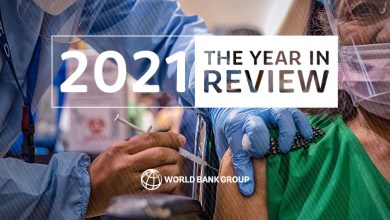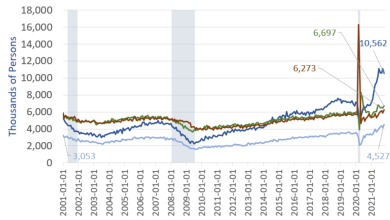Money and Savings Are Not the Same Thing

In the National Income and Product Accounts (NIPA), savings are established as the difference between disposable money income and monetary outlays. Disposable income is defined as the summation of all personal money income less tax payments to the government. Personal income includes wages and salaries, transfer payments, income from interest and dividends, and rental income.
The NIPA framework is based on the Keynesian view that spending by one individual becomes part of the income of another individual. The spending of the purchaser is the income of the seller. From this, it follows that spending equals income.
So if people maintain their spending, this keeps overall income coming in. Now, an increase in the supply of money affects the total amount of money spent. Consequently, the greater the expansion in the money supply, all other things being equal, the more money is going to be spent and therefore the greater the national income is going to be. Therefore, for a given outlay, an increase in money supply will result in an increase in savings.
Note again that in the NIPA’s framework increases in the money supply are an important factor in savings increases. However, does it make sense that increases in the money supply are associated with increases in savings? If this is so, then the central bank can be seen as instrumental to savings formation. Savings are not about money but about the consumer goods that are required to support individuals’ lives and well-being.
How Savings Support Production
Savings are the amount of consumer goods produced in excess of the consumption of these goods. For instance, if a baker produces ten loaves of bread and consumes two loaves, his savings are eight loaves of bread.
Now, in order to enhance his oven, the baker hires the services of a technician. The baker pays the technician with the saved bread. Note that the saved bread enables the technician to maintain his life and well-being while he is busy improving the oven. With an improved oven, the baker can increase the production of bread.
Likewise, the other producers of consumer goods, by exchanging these goods for the services or products of various producers, supply them with the means that support their lives and well-being.
Note that the saved consumer goods support individuals in all the stages of production, from the producers of consumer goods and services to the producers of raw materials, the producers of tools and machinery, and all the other intermediate stages of production.
Observe that if the production of consumer goods were to increase, all other things being equal (i.e., the pool of savings increased), this would further permit the enhancement and the expansion of the infrastructure.
An expanded pool of savings enables individuals to introduce new stages of production that previously could not be undertaken. This in turn permits the production of a larger quantity and a greater variety of consumer goods.
In addition, once there has been an adequate increase in the pool of consumer goods, individuals are in a position to aim at further enhancing their well-being by seeking things such as entertainment and services such as medical treatment.
The saved consumer goods support the lives and well-being of the various individuals that provide entertainment and various services, who require consumer goods in order to maintain their lives and well-being.
Introducing Money
The introduction of money does not alter what we have said so far. A producer of a consumer good exchanges his saved goods for money. He can in turn exchange the money for other goods and services. By exchanging his savings for money, he has supplied the other producer with his saved goods.
As a rule, whenever individuals acquire capital goods such as machinery, they transfer money to the individuals who are employed in the making of the machinery. With the received money, the machinery makers can choose to exchange it not only for consumer goods but also for various services.
Despite its importance as the medium of exchange, according to Murray N. Rothbard, “Money, per se, cannot be consumed and cannot be used directly as a producers’ good in the productive process. Money per se is therefore unproductive; it is dead stock and produces nothing.”
Again, money’s main job is simply to fulfill the role of the medium of exchange. Money does not sustain or fund real economic activity.
However, without the medium of exchange (i.e., money), neither the division of labor nor the market economy could have emerged. The existence of money enables individuals to specialize.
Individuals pay with goods and services they produce—they do not pay with money. Money only helps facilitate payments. It enables the goods of one specialist to be exchanged for the goods of another specialist.
In “Planning for Freedom,” Ludwig von Mises wrote, “Commodities, says Say, are ultimately paid for not by money, but by other commodities. Money is merely the commonly used medium of exchange; it plays only an intermediary role. What the seller wants ultimately to receive in exchange for the commodities sold is other commodities.”
By means of money, an individual can channel savings (i.e., unconsumed consumer goods) to other individuals, which in turn permits the widening of the process of wealth generation. Whenever the individual deems it necessary, he can always exchange his money for goods.
This however, requires that the flow of the produced consumer goods be unabated. Therefore, whenever the holder of money decides to exchange some of it for goods, these goods must be there for him.
Are Money Supply Increases in Response to Demand for Money Harmless?
By some commentators, failing to accommodate an increase in the demand for money can suffocate the economy. In this way of thinking, a corresponding increase in the money supply will be fully absorbed by the demand increase without any bad side effects. On the contrary, an increase in the demand for money is not going to absorb a corresponding increase in the money supply, as occurs with demand for other goods. For instance, a 5 percent increase in the supply of bread will be absorbed by a 5 percent increase in the demand for bread. (Note that the increase in the supply of bread is entirely consumed here—i.e., absorbed by the increased demand).
However, an increase in the demand for money will not absorb the corresponding increase in the money supply. A demand for money is the demand to spend it and not to consume it, as is the case with a demand for bread. The increase in the money supply is going to set in motion an exchange of nothing for something, which will result in the diversion of wealth from wealth-generating to non-wealth-generating activities. This in turn will weaken the process of wealth generation.
An increase in the money supply to accommodate an increase in the demand for money will set in motion all the negatives that an increase in the money supply does, such as the menace of the boom-bust cycle.
Once the market has chosen a particular commodity as money, the given stock of this commodity will always be sufficient to secure the services that money provides. This means that there is no need to increase the money supply in response to an increase in demand.
Within the framework of a free market, there cannot be such thing as “too little” or “too much” money. As long as the market is allowed to clear, no shortage or surplus of money can emerge.
According to Mises:
As the operation of the market tends to determine the final state of money’s purchasing power at a height at which the supply of and the demand for money coincide, there can never be an excess or deficiency of money. Each individual and all individuals together always enjoy fully the advantages which they can derive from indirect exchange and the use of money, no matter whether the total quantity of money is great, or small…. the services which money renders can be neither improved nor repaired by changing the supply of money…. The quantity of money available in the whole economy is always sufficient to secure for everybody all that money does and can do.
Do People Save Money?
People do not save money, but rather they exchange it for goods and services. Once savings (saved consumer goods) are exchanged for money, the holder of the money can employ it immediately in an exchange for other goods or he may hold it temporarily. How an individual decides to employ his money is going to alter his demand for money.
Whether he uses money immediately in an exchange for other goods, puts it under the mattress, or keeps it in his pocket will not alter the given pool of savings.
For instance, by lending money, individuals lower their demand for money. The act of lending does not alter the existing pool of savings.
Likewise, if the owner of money decides to acquire a financial asset such as a bond or a stock, he simply transfers his money to the seller of financial assets—no present savings are affected because of these transactions.
Problems emerge whenever the central bank embarks on monetary pumping, however. When the pumped money is exchanged for consumer goods, it amounts to consumption that is not supported by production. More money is now chasing the same amount of goods.
Consequently, a holder of honest money (i.e., an individual who has produced wealth) discovers that he cannot get the equivalent value of all the goods he previously produced and exchanged for money, all other things being equal. He discovers that the purchasing power of his money has fallen.
Any so-called economic growth in the framework of loose monetary policy can only take place if the private sector manages to grow the pool of savings despite the loose monetary policy undermining this process.
Note again that loose monetary policies give rise to non-wealth-generating activities. Once the pace of non-wealth -generating activities starts to exceed the pace of wealth-generating activities the pool of savings comes under pressure. This in turn sets the platform for a severe economic decline.
Conclusions
Savings are about consumer goods production in excess of the consumption of these goods. Saving is not about money but about final consumer goods that support the lives and well-being of various individuals that are engaged in the various stages of production.
It is not money that funds economic activity but the saved pool of consumer goods. The existence of money only facilitates the flow of savings. Any attempt to replace savings with money ends in an economic disaster.
Source link





